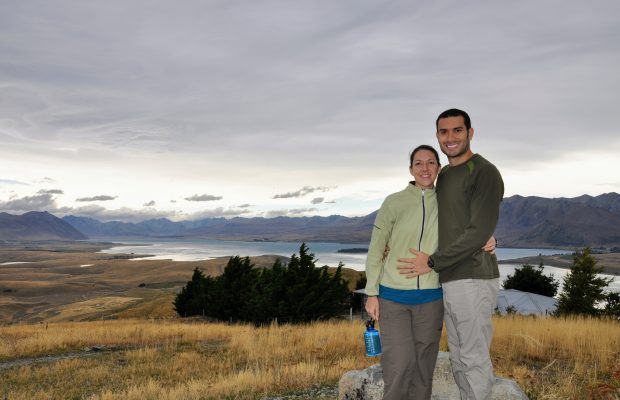Greetings Everyday Spy,
Welcome to your newest #SpyHACK!
In 2012, my wife Jihi and I went on a 3 week trek around New Zealand’s South Island.
We were escaping the rainy season in Bangkok to take a few weeks of much needed R&R (rest & relaxation). The South Island scenery was incredible and the weather was perfect. It was an amazing adventure.
In our newlywed, pre-children days, my wife and I liked to escape as far away from civilization as possible.
Our main goal was to see things and build memories that were truly ours. It’s one thing to stand in line and snap the same Great Wall selfie as 1,000 other tourists. But it’s something totally different to summit a 14,000 ft Colorado peak and spend an afternoon without another human being in sight.
That kind of aloneness builds incredible trust, teamwork, and confidence between partners. It also makes for some memorable romantic moments (G-rated and otherwise).
We had just left the South Island town of Te Anau and Fiordland National Park to head north to Milford Sound.
We had rented a campervan (a small RV) to save time getting around. In New Zealand, travelers are welcome to camp on any public land in the country – and there is a lot! Its called ‘Freedom Camping.’
Jihi and I were taking full advantage of freedom camping in our little 19ft home. We drove an hour out of Te Anau and found an great freedom camping spot that looked west toward Mount Christina. We pulled onto an unmarked dirt road, put on the parking brake, and broke out the grill. Heaven…
Our time with CIA had made us both comfortable with small spaces and remote places.
In many ways, small spaces and minimalist life brought us comfort. Days are simple, waste is low, and mobility is high.
But when injuries happen, being far from professional medical care can escalate quickly toward disaster.
Early the next morning, I got up to use the bathroom (thank you RV camping!!) and went to the kitchen area to wash my hands. It was dark and I was foggy with sleep when I accidentally knocked over the carving knife that was drying from the night before.
Even in my sleepy state I realized that the knife was falling toward my more precious parts and I didn’t have room to dodge it in our cozy little space. So I reached out and grabbed the knife as it fell. I caught it by the blade and felt the metal press into my middle finger in the process. Press, but no pain…
I barely felt the cut (…that’s a good knife), but I felt the blood start to run off my fingertips.
I immediately woke Jihi and told her I had cut myself. She could see I was still holding the knife… over the sink, of course. Let’s be civilized, here.
I felt my adrenaline climbing, she knew to expect the same, so she took over with total calm-headedness.
We were far from any kind of professional medical care. We had minimized our first-aid kit to treat small scrapes/cuts. But this was way too big for a first-aid kit.
We had to lean on our training for treating field wounds.
There are 5 types of open wounds you can get in the field:
- Abrasions – These happen when your skin rubs against a rough surface that causes damage. You may see scrapes and small tears in your skin, but bleeding is minimal.
- Avulsions – These occur when your skin is torn open by force – by an animal, explosion, or other object. Bleeding may be minor or significant but the opening of the wound will be jagged and uneven.
- Punctures – When a wound has a clean, small opening but does deep tissue damage, it’s called a puncture. This can happen with needles and very little blood, or with bullets and knives that cause severe bleeding.
- Lacerations – These happen when skin is cut open by a sharp object. Bleeding is common. Wound openings are more even then with avulsions, but the skin around the wound will still be torn and irritated. This is your most common type of knife cut.
- Incisions – These are deep, clean, straight cuts that cause significant bleeding and almost no skin irritation. Incisions are most common in a hospital setting, but can also happen in everyday life.
When I opened my hand, it was clear that I had a deep laceration.
The tissue toward the tip my finger was fully separated from the tissue in the middle part of my digit. The off-white facia that connects muscle to bone was visible in the cut but still in-tact. The bleeding was continuous but free of the spurting/pulsing that comes with life-threatening bleeding.
There are 5 steps to treating an open wound you get in the field:
- Stop the bleeding – The first and most important step, you have to stop a wound from bleeding. In most cases this means applying pressure to aid the body’s natural clotting process. In extreme cases, this can require turnequets.
- Clean the wound – Cleaning a wound does not mean cleaning inside the wound. It means cleaning the outside the wound to prevent the movement of bacteria into the wound’s opening.
- Treat the wound – This step is intended to aid the body’s natural antibodies (known as immunoglobulins) by keeping the surface of the wound moist and clean. Effective treatment does not renew bleeding.
- Dress the wound – Clean surface dressings are critical to treating a field wound. They keep external bacteria and environmental hazards out and focus the body’s resources on fighting infection and healing.
- Maintain/change the dressing – The body will naturally cycle fluids out of the open wound. These seeping fluids contain living and dead bacteria as well as immunity boosting proteins. Regularly changing dressings removes the old bacteria and encourages the body’s natural healing process.
The most common mistake people make treating wounds is that they FIGHT the body’s natural healing process.
Many common first-aid treatments actually do more harm than good…
- Pouring hydrogen peroxide on an open wound kills a healing enzyme called catalase. The sign that natural catalase is dying is the tell-tale bubbling of hydrogen peroxide.
- Cleaning the wound while it is still bleeding reduces the effectiveness of blood clotting. The body activates platelets in the blood that work to naturally clot open wounds. Washing, dabbing, or wiping a bleeding wound removes platelets before they can clot together.
- Administering ointments into open wounds introduces outside bacteria and can compromise the healing process. Especially in instances when hydrogen peroxide has been used (killing catalase) and clotting has been removed, ointments pushed into a wound can slow healing, increase the risk of infection, and virtually guarantee scarring.
Contrary to Hollywood’s opinion, professional field officers do not think scarring is ‘cool’.
Scarring is a sign that the officer did not take proper care of their wound. They either failed to apply their training correctly or they were incapacitated by the wound and fell into the care of someone less qualified then they are to treat their needs.
A well-treated wound not only allows a war fighter to continue the fight, it also heals quickly and leaves almost no trace behind.
Here is how we treated my laceration according to our training and kept our adventure going strong:
- We stopped the bleeding – My finger was bleeding a lot, and I needed to give the blood a chance to clot. I immediately applied pressure to the cut to slow the bleeding and help the platelets bond. Jihi cracked open a clove of garlic and I placed it on top of the bleeding wound while I maintained pressure.
- Freshly cracked garlic contains a compound known as Allicin, a natural antibiotic that encourages blood clotting. While ingested garlic releases sulfur that actually thins blood, undigested garlic has spectacular healing properties and can be found anywhere in the world.
- We cleaned the surface of the wound – The world is full of dangerous bacteria. One of the most common and dangerous – Staphylococcus – is always present on and around the human body. And the best way to kill it is with common hand soap.
- Water and soap is the most effective way to clean a wound. While hydrogen peroxide, alcohol and even citrus juice can be used, all of these cause counterproductive cellular damage in addition to fighting bacteria. Normal hand soap and water kill 99.9% of harmful bacteria without causing any damage to healthy cells.
- We treated the area – Every field operator’s first-aid kit contains a small tube of antibiotic ointment that contains bacitracin. In my pack, I carry something called Polysporin – an ointment that contains both bacitracin and Polymyxin B, two powerful antibiotics.
- We spread a thin layer of ointment on my wound after the bleeding stopped and only on the surface area on/around the wound. The purpose of the antibiotic is to encourage healing by keeping the area moist while simultaneously killing outside bacteria before they reach the wound.
- We dressed the wound – Very few carry sterile gauze around. As soon as sterilized gauze is opened, it’s no longer sterile! That’s okay, because the bacitracin ointment keeps the wound clean, not the dressing.
- Any porous fabric can make an effective dressing. Cotton blended hand cloths, shirts, or even socks turned inside out can cover and protect a wound from the environment. We tore the sleeves off an old t-shirt and cut them both in half (with the same knife that cut me!). BOOM – four finger dressings that we could rotate and clean by hand.
- We changed dressing as needed – The human body is amazing in its grossness. I grew up with a nurse as a mom who was fearless about gross body stuff. I can’t thank her enough now for her superhuman ability to deal with anything and everything that came out of me as a child… I LOVE YOU, MOM!
- My dressing got oozy and bloody and discolored about every 12 hours. We washed the area and reapplied ointment each time we changed the dressings. In about 36 hours the wound was fully sealed and my finger had resumed the appearance of one piece of continuous flesh – no staples, stitches, or glue needed.
The most effective way to treat a field wound is to encourage and assist the body’s natural healing process.
Our adventure to Milford Sound went uninterrupted, and by the time we crossed back through Te Anau I was rocking a standard sized band-aid that I changed one time a day.
The human body works amazingly well.
It can get you and me through almost anything if we give it the tools it needs to do what it does best.
Godspeed, #EverydaySpy
Author: Andrew Bustamante, Founder of www.EverydaySpy.com. Andrew is a former covert CIA Intelligence officer, decorated US Air Force Combat Veteran, and respected Fortune 500 senior advisor. Learn more from Andrew on his Podcast (The Everyday Espionage Podcast) and by following @EverydaySpy on your favorite social media platform.


